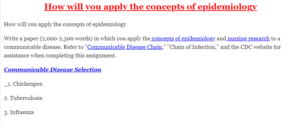How will you apply the concepts of epidemiology
How will you apply the concepts of epidemiology
How will you apply the concepts of epidemiology
Write a paper (2,000-2,500 words) in which you apply the concepts of epidemiology and nursing research to a communicable disease. Refer to “Communicable Disease Chain,” “Chain of Infection,” and the CDC website for assistance when completing this assignment.
Communicable Disease Selection
_1. Chickenpox
2. Tuberculosis
3. Influenza
4. Mononucleosis
5. Hepatitis B
6. HIV
7. Ebola
8. Measles
9. Polio
10. Influenza
Epidemiology Paper Requirements
1. Describe the chosen communicable disease, including causes, symptoms, mode of transmission, complications, treatment, and the demographic of interest (mortality, morbidity, incidence, and prevalence). Is this a reportable disease? If so, provide details about reporting time, whom to report to, etc.
2. Describe the social determinants of health and explain how those factors contribute to the development of this disease.
3. Discuss the epidemiologic triangle as it relates to the communicable disease you have selected. Include the host factors, agent factors (presence or absence), and environmental factors. Are there any special considerations or notifications for the community, schools, or general population?
4. Explain the role of the com_munity health nurse (case finding, reporting, data collection, data analysis, and follow-up) and why demographic data are necessary to the health of the community.
5. Identify at least one national agency or organization that addresses the communicable disease chosen and describe how the organizations contribute to resolving or reducing the impact of disease.
6. Discuss a global implication of the disease. How is this addressed in other countries or cultures? Is this disease endemic to a particular area? Provide an example.
A minimum of three peer-reviewed or professional references is required.
Prepare this assignment according to the guidelines found in the APA Style Guide, located in the Student Success Center. An abstract is not required.
This assignment uses a rubric. Please review the rubric prior to beginning the assignment to become familiar with the expectations for successful completion.
_
https://lms-ugrad.gcu.edu/learningPlatform/content/content.lc?operation=viewContent&contentId=f6f42737-361e-4bf7-b4f6-84c03a5ddfd9
http://lc.gcumedia.com/nsg403c/chain-of-infection/chain-of-infection-v1.1.html
http://www.healthypeople.gov/2020/topicsobjectives2020/overview.aspx?topicid=39
https://wwwn.cdc.gov/nndss/conditions/notifiable/2017/
https://www.cdc.gov/
https://www.hhs.gov/
http://www.who.int/en/
http://www.familiesusa.org/
https://wwwn.cdc.gov/nndss/conditions/notifiable/2017/
http://www.who.int/en/
n of Infection Model is used to understand the process of disease transmission. Each link represents a step in the transmission of infection to a susceptible “host”. Each link must be present for an infection to occur.
An infectious agent may be transmitted in several different ways, but there is usually a predominant mode of transmission. “The spread of infection is best described as a chain with six links:
• A pathogen or causative agent
• A reservoir (human, animal, or environmental source of the pathogen)
• A portal of exit from the reservoir
• Mode of transmission
• A portal of entry into a susceptible host
• A susceptible host
If you can break any link of the chain of infection, you can prevent the occurrence of new infection. Infection control measures are designed to break the links and thereby prevent new infections. The chain of infection is the foundation of infection prevention” (Wild Iris Medical Education, 2012, para. 35).
References:
Wild Iris Medical E_ducation. (2012). Infection control. Retrieved from http://www.nursingceu.com/courses/375/index_nceu.html
Centers for Disease Control and Prevention. (2012). Lesson 1: Introduction to epidemiology—Section 10: Chain of infection. In Principles of Epidemiology in Public Health Practice (3rd ed.) [Self-Study Course SS1978]. Retrieved from: http://www.cdc.gov/osels/scientific_edu/ss1978/lesson1/Section10.htm
INTRODUCTION
The Chain of Infection Model is used to understand the process of disease transmission. Each link represents a step in the transmission of infection to a susceptible “host”. Each link must be present for an infection to occur.
An infectious agent may be transmitted in seera different ways, but there is usually a predominant mode of transmission. “The spread of infection is best described as a chain with six links:
• A pathogen or causative agent
• A resetry into a susceptible host
• A susceptible host
If you can break any link of the chain of infection, you can prevent the occurrence of new infection. Infection control measures are designed to break the links and thereby prevent new infections. The chain of infection is the foundation of infection prevention” (Wild Iris Medical Education, 2012, para. 35).
References:
Wild Iris Medical Education. (2012). Infection control. Retrieved from http://www.nursingceu.com/courses/375/index_nceu.html
Centers for Disease Cont: Chain of infection. In Principles of Epidemiology in Public Health Practice (3rd ed.) [Self-Study Course SS1978]. Retrieved from: http://www.cdc.gov/osels/scientific_edu/ss1978/lesson1/Section
INTRODUCTIO
The Chain of Infection Model is used o undersor an ias a cain with six links
• A pathogen or ce
• A reservoir (human, animal, or environmental source of the pathogen)
• A portal of exit from the reservoir
• Mode of transmission
• A portal of entry into a susceptible host
• A susceptible host
If you can break any link of the chain of infection, you can prevent the occurrence of new infection. Infection control measures are designed to break the links and thereby prevent new infections. The chain of infection is the foundation of infection prevention” (Wild Iris Medical Education, 2012, para. 35).
References:
Wild Iris Medical Education. (2012). Infection control. Retrieved from http://www.nursingceu.com/courses/375/index_nceu.html
Centers for Disease Control and Prevention. (2012). Lesson 1: Introduction to epidemiology—Section 10: Chain of infection. In Principles of Epidemiology in Public Health Practice (3rd ed.) [Self-Study Course SS1978]. Retrieved from: http://www.cdc.gosels/scientific_edu/ss1978/lesson1/Section10.htINFECTIO
Use the following coupon code :
NursesHomework


